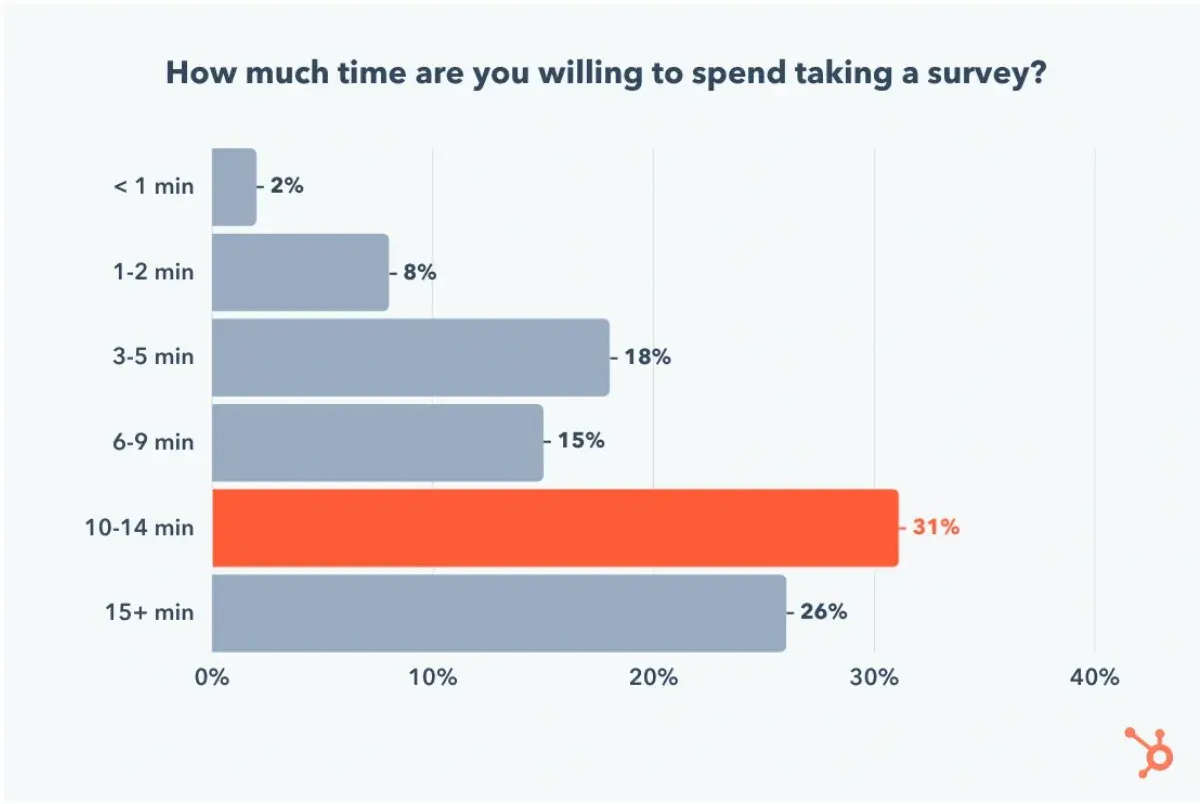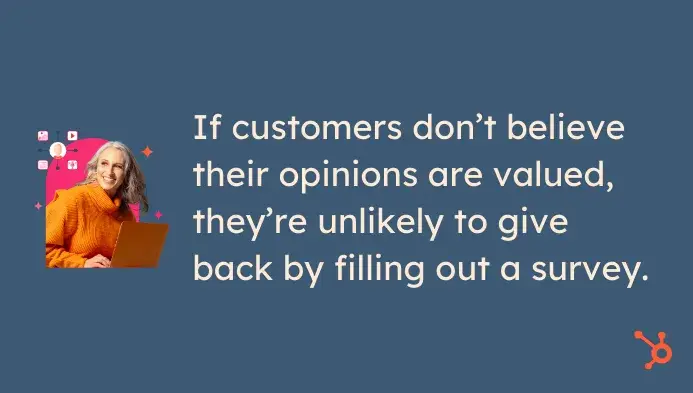In this post, I’ll discuss:
- What is survey fatigue?
- Confessions of Survey Quitters: What Research Says About Participant Fatigue
- The Negative Consequences of Survey Fatigue
- How to Avoid Survey Fatigue: 9 Tips for Better Survey Methodology
- The Benefits of a Well-Designed Customer Survey
What is survey fatigue?
Survey fatigue, also called participant fatigue, is when respondents lose interest, become bored, or lack motivation for taking a survey. This can be due to the large number of survey requests they receive or the amount of effort required to complete the survey. Fatigue can lead to low response rates, inaccurate answers, or abandonment, which affects survey results.
Since surveys are tools to gain direct responses from your customers about their level of satisfaction (or dissatisfaction) and potentially foster stronger relationships, collecting a range of accurate feedback is important for improving your product or service and ultimately meeting your business goals.
This means that finding ways to reduce participant fatigue is vital to gaining new insights that reflect your customers’ real experiences and opinions.
Confessions of Survey Quitters: What Research Says About Participant Fatigue
When HubSpot asked 100 consumers in the U.S. about their ideal survey length, the results were mixed. While the single-category majority (31%) said that they’re willing to spend 10-14 minutes taking a survey, 43% of people preferred times lower than that.

Overall, less time and fewer questions were valued as factors that increase the likelihood of survey completion. But is it really just a problem of not having enough hours in the day? Or is something else behind the lack of motivation?
What causes survey fatigue?
The above study coincides with scientific research that shows the longer a survey takes, the more questions will be skipped, “suggesting that cognitive burden is a key driver to survey fatigue.”
In short: We’re getting burned out.
And while you might think that medical science doesn’t have much to do with marketing, the fact that both fields use surveys as a part of their interactions with customers or patients means that they run into the same problems — and can help each other out with the solutions.
In healthcare, for example, where the aim is to understand the feelings, experiences, habits, and opinions of a certain group (sound familiar?), a 2024 roundup of problems in the Journal of Caring Sciences highlighted survey fatigue as a result of:
- Long surveys.
- Extensive follow-up questions.
- Targeting the incorrect participants.
- Poor survey design.
- Repetitive questions.
- Too many open-ended questions.
- Over-surveying (i.e., too many surveys are sent).
This lines up with recent customer experience research, where 1,000 U.S. respondents named survey length, quantity of surveys, and the timing of when a survey is received as important reasons for whether or not they complete a survey.
But, according to the same study, one of the biggest considerations is if they feel their voice is being heard. If customers don’t believe their opinions are valued, they’re unlikely to give back by filling out a survey.
“Many people appreciate the opportunity to express their opinions and feel like they're contributing to something bigger,” says Oleg Pikar, head of customer experience for Europe and China at Maserati.
Follow-up is an important part of the game to ensure customers understand that they’re not just throwing their precious survey-taking time into a void.

The Negative Consequences of Survey Fatigue
Knowing what causes fatigue is the first step, but why is it important? How do the causes of fatigue affect the survey outcomes?
Here’s the shortlist for how participant fatigue affects business.
Low Response Rates
When respondents are fatigued, they may not finish, or even start, the survey. Non-response means less data to analyze and work with, but also can lead to bias in the set of responses you do receive.
Inaccurate Responses
Inaccurate or rushed responses can result from too many questions or questions that are not pertinent to the specific customer taking the survey. This can lead to inaccurate insights from your analyses, since the answers aren’t a true reflection of the consumer.
Skewed Results
Extremely satisfied or dissatisfied customers are more likely to express their opinions, while those who feel less strongly in either direction may not respond. This means your data may be skewed, missing the entire section in the middle.
Brand Erosion
When customers are overwhelmed by surveys, they may begin to view your brand in a negative light, lose trust, or unsubscribe from communications. This is counter to the purpose of sending surveys in the first place.
In order to keep the door open to building trust, loyalty, and community, thoughtful survey design is a must.
How to Avoid Survey Fatigue: 9 Tips for Better Survey Methodology
Since surveys are one of the best and simplest ways to gather direct feedback from customers, completely cutting them out of your strategy is not the answer.
Instead, I recommend adding these specific steps to your survey methodology in order to reduce fatigue.

1. Consider frequency and timing.
To determine the best possible timing, I would first take a few things into account:
- Are other departments in your organization administering surveys? If so, how often? Do they overlap with when your survey goes out?
- How often do your customers interact with you?
- How often do your competitors send surveys and when?
For B2B companies, you can send customers surveys quarterly or consider how often they interact with your company, and then divide that by two. For example, if interactions are monthly, you can send a survey every other month, and if weekly, you can send a survey every other week.
However, if you send transactional surveys (a survey sent after each purchase), it’s okay to keep up that frequency, so long as you keep it short and directed at the specific encounter. And be sure to send it out as close to the transaction time as possible, since some data suggest that up to 84% of clients are more likely to respond just following an interaction.
2. Be mindful of the number of questions.
While this can vary depending on what information you're attempting to collect, the general rule is that the more straightforward and concise a survey, the better.
Consider the Net Promoter Score (NPS), for example. Part of its enduring appeal and success is that it asks customers to answer just one question (“On a scale of 0 to 10, how likely are you to recommend to a friend?”). The idea is to have more people who will promote your business than those who won’t.
Pro tip: One way I analyze the drain of answering questions is to pretend I’m a customer and take the survey myself. Is it dragging? Is it redundant? Are all the questions necessary? If it feels like there are too many questions, go with your gut. Your customers will likely feel that as well.
3. Know how long the survey takes to complete (and give estimates).
While the number of questions is one factor, the total length of time the survey takes to complete is another. Keep in mind that closed-ended questions (e.g., multiple choice) are faster to answer than open-ended questions (those that require a write-in response).
Ideally, your survey should include both types, but this will depend on what information you’re trying to access. If the information can be extracted from multiple-choice questions or a scaled answer, use that type.
But if you want to understand why respondents have those opinions, open-ended questions will work better.
In addition, since we know that shorter surveys have a higher chance of being completed, give an estimate of how long the survey should take to finish. For example, “Take our three-minute survey to help us improve our member experience!”
4. Communicate why you're sending the survey.
When sending a survey, be sure to give a concise reason for why you’re requesting feedback.
As noted above, survey respondents want to feel like their opinion matters and will contribute to a larger whole. Make sure to state how their response will have an impact.
A great way to achieve this is to call out the benefits it will have for the participant. For example, “so we can add new features to enhance your experience.”
5. Ask the right questions, in the right order, with no overlap.
Writing good survey questions takes time to perfect. Not only do you want to ask the most precise questions to gain useful information, but you also want to be clear and avoid confusion.
Here are my suggestions for writing clear questions:
- Avoid double negatives.
- Don’t ask: What don't we currently offer that would make you less likely to cancel your membership?
- Do ask: What else could we offer that would add value to your membership?
- Be specific.
- Don’t ask: How do you feel about your purchase?
- Do ask: How satisfied are you with the quality of the product you received?
- Only show questions that apply to the specific participant or response.
- Example: If you ask, "How satisfied are you with the quality of the product you received?", you can jump to the pertinent follow-up question based on whether they were satisfied or dissatisfied, thereby skipping irrelevant questions.
- Avoid double-barreled questions. If a single question asks about more than one topic, but allows for only one response, you’ve got a double-barreled question. These are often impossible to answer accurately.
- Don’t ask: How satisfied are you with the product and delivery?
- Do ask: “How satisfied are you with the product?” And then, as a second question, “How satisfied are you with the delivery?”
- Ensure numbers don’t overlap in multiple-choice ranges. When this happens, more than one response is correct for a single participant, which leads to inaccuracies in the data.
- Don’t write: Select your age range: 18-25; 25-35; 35-45 (etc.)
- Do write: Select your age range: 18-24; 25-34; 35-44 (etc.)
And don’t forget that order matters.
Survey design is a bit like storytelling in the sense that participants can’t answer a question about what they purchased before you’ve asked them if they’ve purchased.
This is another reason to state the purpose of the survey at the beginning, so respondents can think in that arena.
6. Limit personal information (and state why it’s necessary).
Asking for too much personal or demographic information is a recurring reason why respondents drop out of surveys. While the causes aren’t always clear, I’ve considered a few possible reasons.
- Answering demographic questions adds length to the survey, both in number of questions and total time. As noted above, this is one reason for survey fatigue.
- When providing sensitive or negative feedback, participants may not trust that their identity will remain anonymous.
- Also related to trust, participants may not see how their age, race, or income is relevant, leading them to abandon the survey out of distrust or frustration.
Pro tip: If you want to ask for contact information or demographics as part of your customer segmentation strategy, include them in optional questions at the end. In addition, if the information is crucial, be sure to explain beforehand why you’re collecting it and how it will be used.
7. Add visuals.
Surveys involving photos, videos, or other appealing visuals are more energizing than text alone.
I’ve found an easy way to incorporate questions with images, for example, is to ask customers to click emoji faces instead of numbers on a scale.
8. Test your survey before sending it out.
I like to invite a few people outside of my immediate team to test a survey before I finalize it. I ask them to share how long it took to complete and to identify any questions that weren't clear, caused confusion, seemed irrelevant, or made them want to stop taking the survey altogether.
Afterward, I can cut down on survey fatigue by eliminating the places that trip up respondents.
9. Use survey templates to ensure a better design.
The best way to ensure that your surveys tick all the boxes to avoid fatigue — especially if you’re just starting out — is to use templates for your design.
HubSpot’s free customer satisfaction survey templates are a great place to begin, so you can put your surveys into action quickly and start collecting the results.
The Benefits of a Well-Designed Customer Survey
While speaking directly with customers can lead to deeper insights, surveys remain a simple and cost-effective option for hearing directly about experiences with your brand. And even with survey fatigue taking its toll, many people still acknowledge that they like taking surveys (and I’m one of them).
As someone sitting on both sides of the table, I can say that clarity, concision, and communicating your purpose go a long way in reducing fatigue — and making sure your participants feel heard, valued, and like they want to give back.
Editor's note: This post was originally published in January 2022 and has been updated for comprehensiveness.
Survey Creation
.png?width=112&height=112&name=Image%20Hackathon%20%E2%80%93%20Horizontal%20(24).png)

.webp)
![16 best free online survey makers and tools [+ recommendations]](https://53.fs1.hubspotusercontent-na1.net/hubfs/53/free-online-survey-maker-1-20251028-2654831.webp)


![How to conduct survey analysis like a data pro [all my tips + secrets]](https://53.fs1.hubspotusercontent-na1.net/hubfs/53/survey-results-1-20241031-6355381.webp)
![Leading questions: What they are & why they matter [+ Examples]](https://53.fs1.hubspotusercontent-na1.net/hubfs/53/leading-questions-hero.webp)
![How long should a survey be? The ideal survey length [New data]](https://53.fs1.hubspotusercontent-na1.net/hubfs/53/how%20long%20should%20a%20survey%20be_featured.png)



